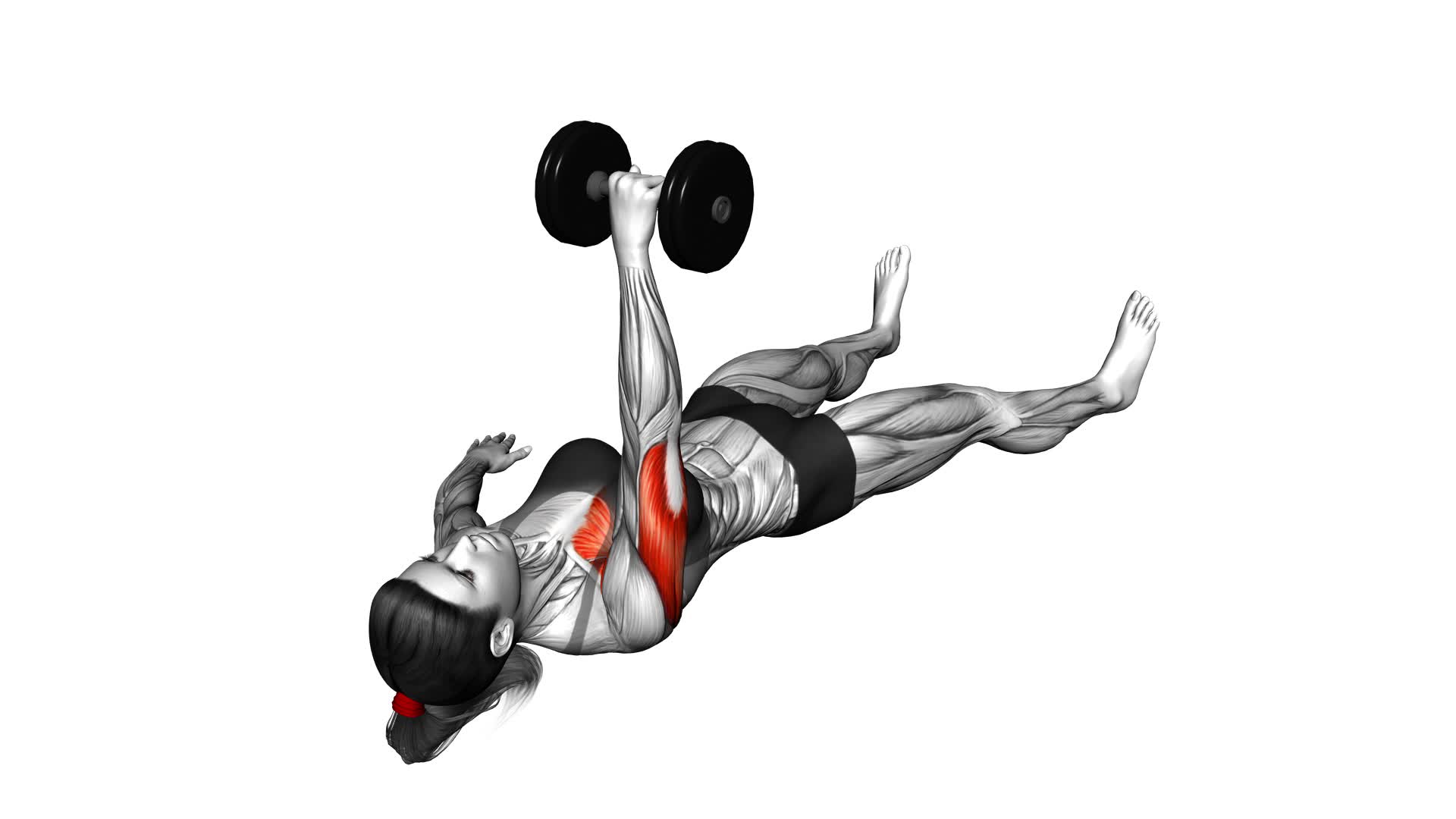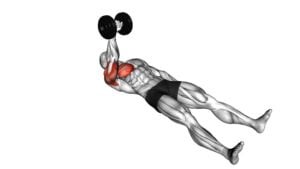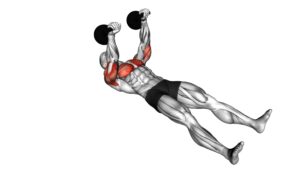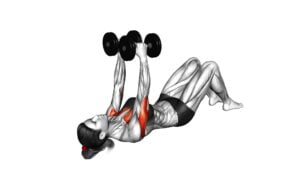Dumbbell Alternating Floor Press (female) – Video Exercise Guide & Tips

Are you looking for a challenging and effective exercise to target your chest and arms? Look no further than the dumbbell alternating floor press!
Watch This Exercise Video
This exercise is perfect for females who want to tone and strengthen their upper body.
In this video exercise guide, you'll learn proper form and technique to maximize your results.
Whether you're a beginner or more advanced, there are variations and modifications to suit your fitness level.
Get ready to incorporate the dumbbell alternating floor press into your workout routine for amazing results!
Key Takeaways
- Dumbbell alternating floor press targets the chest, shoulders, and triceps.
- It engages the core and improves balance.
- It works each side of the body independently, correcting imbalances in strength and muscle development.
- The exercise maximizes upper body strength and stability.
Benefits of the Dumbbell Alternating Floor Press
You can maximize your upper body strength and stability with the benefits of the Dumbbell Alternating Floor Press. This exercise is a fantastic way to target your chest, shoulders, and triceps, while also engaging your core and improving your balance. One of the key benefits of the Dumbbell Alternating Floor Press is that it allows you to work each side of your body independently, which helps to correct any imbalances in strength or muscle development.
Technique is crucial when performing the Dumbbell Alternating Floor Press to ensure that you're reaping its full benefits. Start by lying flat on your back on the floor with your knees bent and your feet flat on the ground. Hold a dumbbell in each hand just above your shoulders, with your palms facing forward. As you press one dumbbell upwards, keep the other arm extended at a 90-degree angle, maintaining tension in your chest and triceps. Lower the dumbbell back down to the starting position and repeat on the other side.
Proper Form and Technique for the Exercise
To perform the Dumbbell Alternating Floor Press with proper form and technique, it's important to focus on two key points: maintaining alignment of your elbows and chest, and engaging your core while breathing properly.
When performing the exercise, keep your elbows close to your sides and in line with your chest to ensure proper alignment and maximize the effectiveness of the movement.
Additionally, engage your core muscles and breathe out as you press the dumbbell up, and breathe in as you lower it back down to the starting position.
Elbows and Chest Alignment
Maintain proper alignment of your elbows and chest throughout the Dumbbell Alternating Floor Press exercise. Proper elbow positioning is crucial to ensure proper muscle activation and maximize the effectiveness of the exercise.
Start by lying on your back with your knees bent and feet flat on the floor. Hold a dumbbell in each hand, with your palms facing towards your feet. As you lower the dumbbell towards your chest, make sure your elbows are at a 90-degree angle, forming a right angle. Avoid letting your elbows flare out to the sides or collapse inwards.
Keep your chest lifted and engaged throughout the movement to maintain proper alignment. This will help target the chest muscles and prevent unnecessary strain on the shoulders and elbows.
Remember to focus on maintaining this alignment throughout the entire exercise for optimal results.
Breathing and Core Engagement
To ensure proper form and technique for the Dumbbell Alternating Floor Press, focus on your breathing and engage your core throughout the exercise. Proper breathing techniques and core activation are crucial for maximizing the effectiveness of this exercise and preventing injury.
Here are three key points to keep in mind:
- Breathe out during the pressing phase: As you push the dumbbell away from your body, exhale forcefully through your mouth. This will help you generate more power and maintain stability.
- Engage your core: Before you start the exercise, brace your abdominal muscles as if you were preparing to be punched in the stomach. This will provide a solid foundation and protect your lower back.
- Maintain core engagement throughout: Throughout the entire movement, keep your core muscles tight and activated. This will help stabilize your spine and enhance overall strength and control.
Choosing the Right Dumbbell Weight for You
Choose a dumbbell weight that challenges you without sacrificing proper form or causing excessive strain. When it comes to selecting the right dumbbell weight for you, there are a few tips to keep in mind.
First, consider your current strength and fitness level. If you're a beginner, start with lighter weights and gradually increase as you become more comfortable and confident with the exercise. On the other hand, if you're more experienced, you may need to choose heavier weights to continue challenging your muscles.
Next, pay attention to your form. If you find yourself struggling to maintain proper technique, it may be a sign that the dumbbell weight is too heavy for you. It's important to prioritize good form to prevent injuries and maximize the effectiveness of the exercise.
Lastly, listen to your body. If you feel excessive strain or pain during the exercise, it's a clear indication that the dumbbell weight is too heavy. Adjust the weight accordingly to ensure a safe and effective workout.
Common Mistakes to Avoid During the Floor Press
When performing the floor press, it's important to avoid two common mistakes.
First, make sure your elbows aren't too wide, as this can put unnecessary strain on your shoulders. Keep them tucked in close to your body for proper form and to target the intended muscles.
Second, be mindful of your stability throughout the exercise. Maintaining a strong and stable core will help you maintain control and maximize the effectiveness of the floor press.
Elbows Too Wide
Keep your elbows close to your body when performing the floor press to avoid the common mistake of having elbows too wide. Maintaining proper elbow alignment is crucial for shoulder stability and to maximize the effectiveness of the exercise.
Here are three reasons why you should keep your elbows in:
- Improved shoulder stability: By keeping your elbows tucked in, you create a stable base for your shoulders, reducing the risk of injury and allowing you to lift heavier weights.
- Increased triceps activation: When your elbows are close to your body, your triceps are engaged throughout the movement, leading to stronger and more defined arms.
- Enhanced chest activation: Bringing your elbows in targets your chest muscles more effectively, helping you build a stronger and more sculpted upper body.
By keeping your elbows in, you not only improve your shoulder stability but also maximize the benefits of the floor press.
Now, let's move on to the next common mistake: lack of stability.
Lack of Stability
To ensure proper form and avoid common mistakes during the floor press, it's important to focus on maintaining stability throughout the exercise. Lack of stability can lead to decreased performance and potential injuries.
To improve stability, incorporate exercises that target balance and core strength. One effective exercise is the single-leg deadlift. Start by standing on one leg and hinge forward at your hips while keeping your back straight. Extend the opposite leg behind you for balance.
Another exercise that can help improve stability is the plank. Get into a push-up position, but instead of resting on your hands, lower down onto your forearms. Engage your core and hold this position for as long as you can.
Variations and Modifications for Different Fitness Levels
Looking to adjust the dumbbell alternating floor press to your fitness level? No worries! Whether you're a beginner or an advanced fitness enthusiast, there are variations and modifications available to suit your needs.
Here are three options to consider:
- Weight modifications: If you're just starting out or have limited upper body strength, you can begin with lighter dumbbells. As you progress, gradually increase the weight to challenge yourself and build strength.
- Range of motion modifications: If you find it difficult to fully extend your arms during the floor press, you can modify the exercise by decreasing the range of motion. Instead of lowering the dumbbells all the way to the floor, you can stop at a comfortable point and then press them back up.
- Stability modifications: If you struggle with stability, you can perform the floor press with your feet flat on the ground instead of elevating them. This will provide a more stable base and make the exercise easier to perform.
Tips for Incorporating the Dumbbell Alternating Floor Press Into Your Workout Routine
To incorporate the dumbbell alternating floor press into your workout routine, start by selecting an appropriate weight and positioning yourself on the floor. The floor press is a great exercise for building upper body strength, particularly in the chest, shoulders, and triceps.
To perform the exercise, lie flat on your back with your knees bent and your feet flat on the ground. Hold a dumbbell in each hand, with your palms facing forward and your elbows bent at a 90-degree angle. Begin by pressing one dumbbell straight up towards the ceiling, while keeping the other dumbbell lowered to the starting position. Lower the dumbbell back down to the starting position and repeat on the opposite side. Continue alternating sides for the desired number of repetitions.
When incorporating the floor press into your workout routine, it's important to consider any modifications that may be needed based on your fitness level. If you're new to the exercise or have limited upper body strength, you may want to start with lighter weights or even just your body weight until you feel comfortable and confident. As you become stronger, you can gradually increase the weight to continue challenging your muscles.
Additionally, you can vary the tempo of the exercise by performing the floor press at a slower pace to increase time under tension and further engage your muscles. Remember to always listen to your body and adjust the exercise as needed to prevent any discomfort or injury.
Frequently Asked Questions
How Often Should I Perform the Dumbbell Alternating Floor Press Exercise?
To determine the ideal workout frequency for the dumbbell alternating floor press exercise, consider your fitness goals and current level of strength.
It's generally recommended to perform this exercise 2-3 times per week, allowing for rest days in between.
However, you can also incorporate variations of the dumbbell alternating floor press, such as using different weights or adding in pauses, to challenge your muscles and prevent plateauing.
Always listen to your body and adjust the frequency as needed.
Can the Dumbbell Alternating Floor Press Help Me Build Muscle in My Chest?
The dumbbell alternating floor press is an effective exercise for building muscle in your chest. By incorporating dumbbell floor press variations into your workout routine, you can target your chest muscles from different angles, promoting muscle growth and strength.
Floor exercises, like the dumbbell alternating floor press, have the added benefit of engaging your stabilizer muscles, improving overall balance and coordination. Incorporating this exercise into your routine can help you achieve your chest muscle-building goals.
Is It Necessary to Have a Spotter While Performing the Dumbbell Alternating Floor Press?
Having a spotter while performing the dumbbell alternating floor press isn't necessary, but it can be beneficial. A spotter can provide assistance in case you struggle with the weights or need help maintaining proper form.
However, if you don't have access to a spotter, there are alternatives you can try, such as using lighter weights or performing the exercise on a bench instead of the floor.
Remember to always prioritize safety and listen to your body.
Can I Perform the Dumbbell Alternating Floor Press if I Have Shoulder or Wrist Injuries?
If you have shoulder or wrist injuries, it's important to modify or find alternative exercises that won't exacerbate your condition.
For the dumbbell alternating floor press, you may want to consider using lighter weights or even resistance bands to reduce strain on your shoulders and wrists.
Additionally, you can try exercises like push-ups or chest presses using a stability ball, which can help target similar muscle groups without putting as much pressure on your injured areas.
Are There Any Specific Breathing Techniques I Should Follow During the Dumbbell Alternating Floor Press Exercise?
When performing the dumbbell alternating floor press, it's important to focus on your breathing technique. Breathing properly can help you maintain stability and control throughout the exercise.
As you lower the dumbbell to the floor, exhale, and as you push it back up, inhale. This rhythmic breathing pattern can help you engage your core muscles and increase your overall strength.
The dumbbell alternating floor press is a great exercise for improving upper body strength and stability.
Conclusion
In conclusion, the dumbbell alternating floor press is a highly effective exercise for strengthening the chest, shoulders, and arms. By using proper form and technique, choosing the right dumbbell weight, and avoiding common mistakes, you can maximize the benefits of this exercise.
Additionally, there are variations and modifications available for different fitness levels, making it suitable for everyone. Incorporating the dumbbell alternating floor press into your workout routine can help you achieve your fitness goals and improve overall upper body strength.

Author
Years ago, the spark of my life’s passion ignited in my mind the moment I stepped into the local gym for the first time. The inaugural bead of perspiration, the initial endeavor, the very first surge of endorphins, and a sense of pride that washed over me post-workout marked the beginning of my deep-seated interest in strength sports, fitness, and sports nutrition. This very curiosity blossomed rapidly into a profound fascination, propelling me to earn a Master’s degree in Physical Education from the Academy of Physical Education in Krakow, followed by a Sports Manager diploma from the Jagiellonian University. My journey of growth led me to gain more specialized qualifications, such as being a certified personal trainer with a focus on sports dietetics, a lifeguard, and an instructor for wellness and corrective gymnastics. Theoretical knowledge paired seamlessly with practical experience, reinforcing my belief that the transformation of individuals under my guidance was also a reflection of my personal growth. This belief holds true even today. Each day, I strive to push the boundaries and explore new realms. These realms gently elevate me to greater heights. The unique combination of passion for my field and the continuous quest for growth fuels my drive to break new ground.







